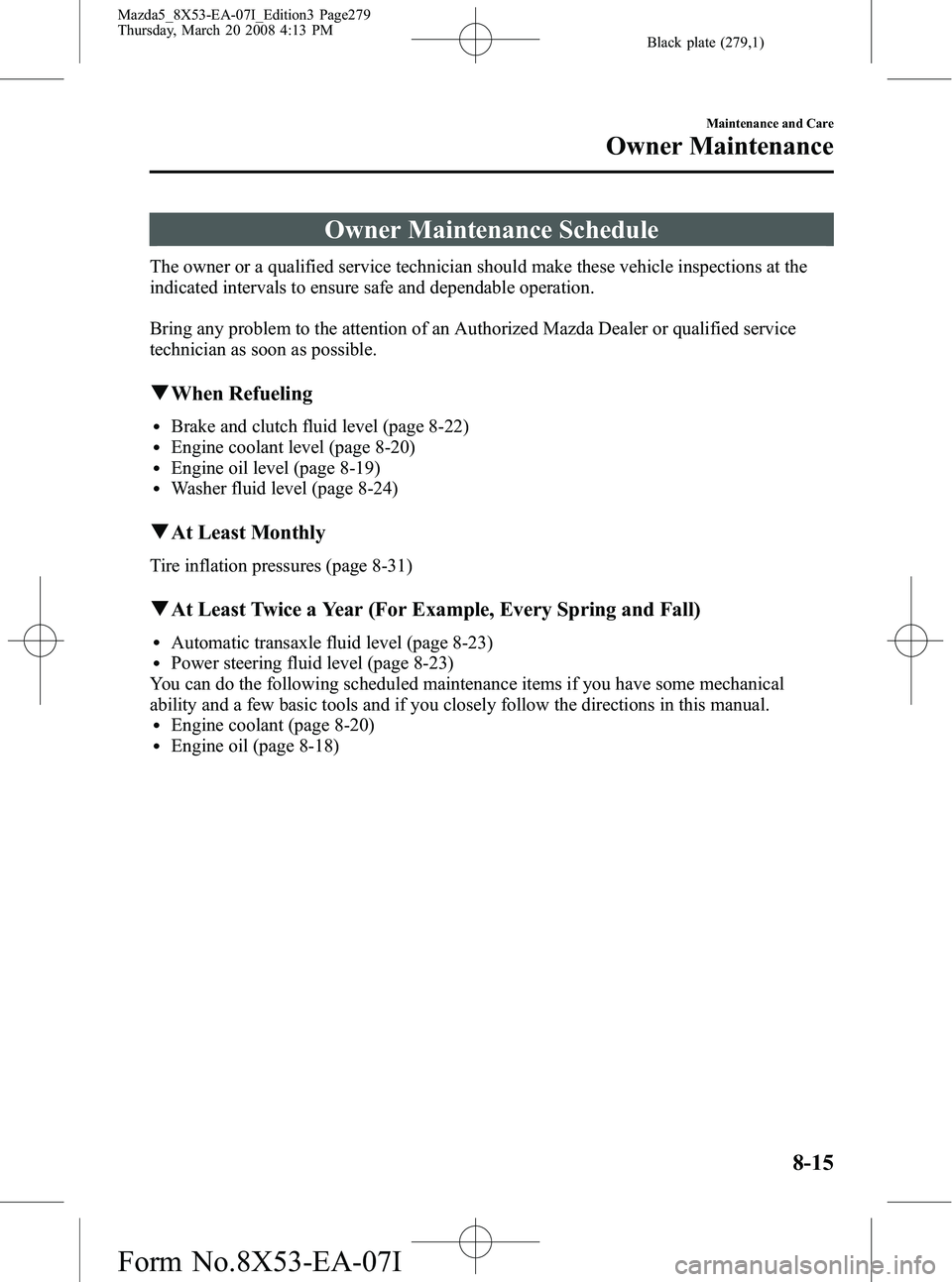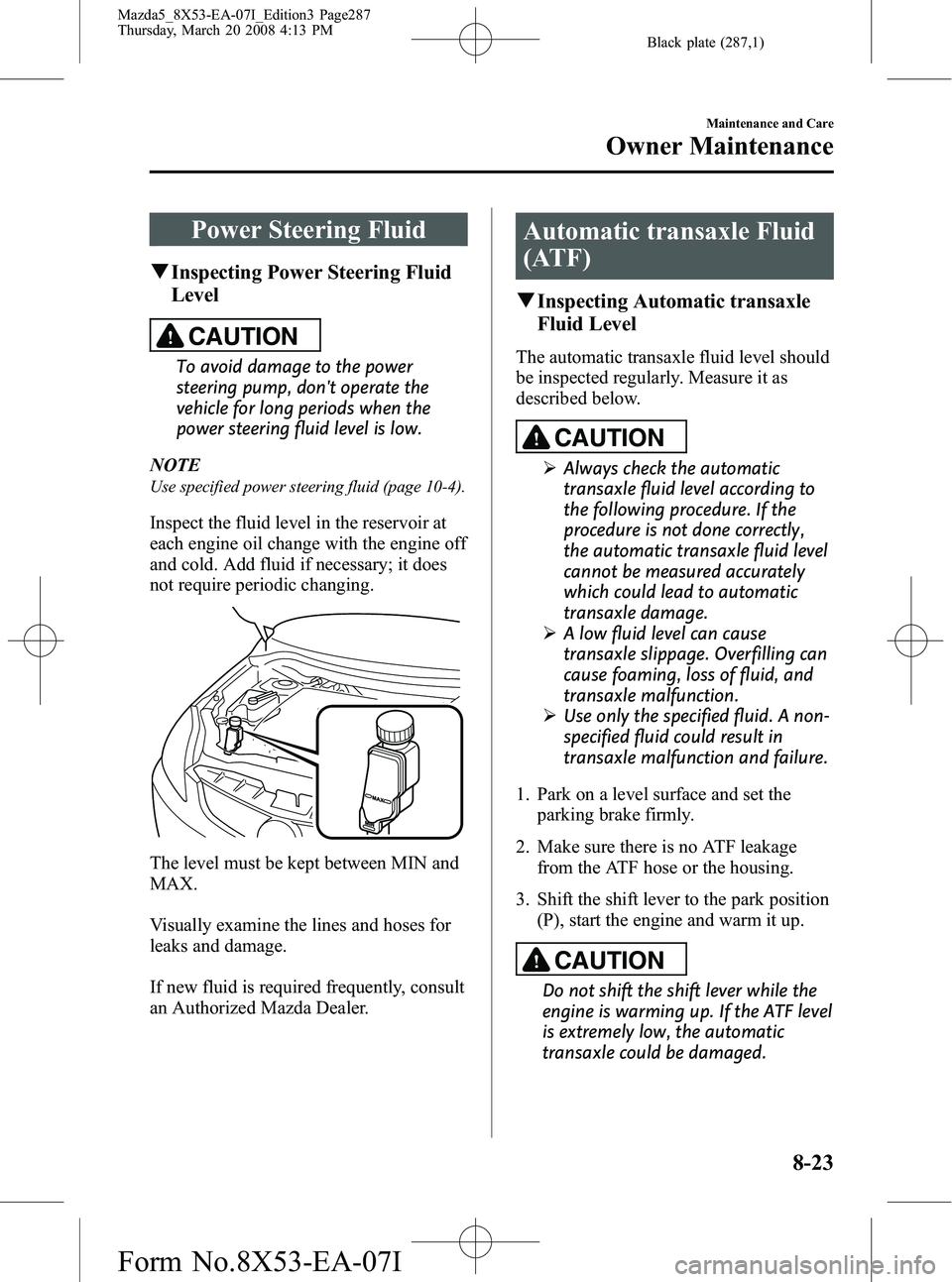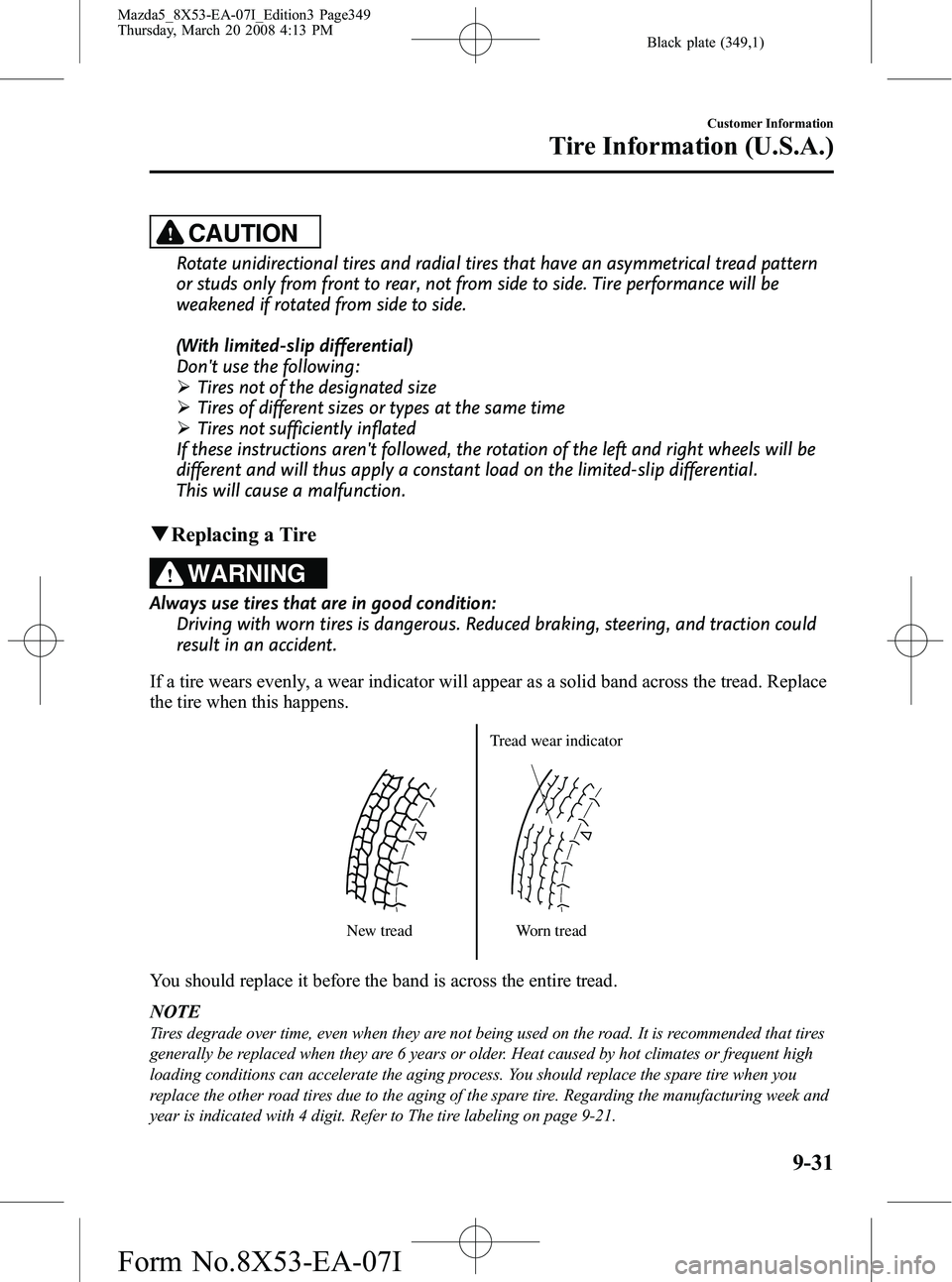steering MAZDA MODEL 5 2008 Owner's Guide
[x] Cancel search | Manufacturer: MAZDA, Model Year: 2008, Model line: MODEL 5, Model: MAZDA MODEL 5 2008Pages: 376, PDF Size: 4.7 MB
Page 273 of 376

Black plate (273,1)
qSchedule 1
Maintenance Interval Number of months or kilometers, whichever comes first
Months 6 12 18 24 30 36 42 48 54 60 66 72
×1000 km 10 20 30 40 50 60 70 80 90 100 110 120
ENGINE
Engine valve clearance Audible inspect every 120,000 km, if noisy, adjust
Drive belts II I
Engine oil RRRRRRRRRRRR
Engine oil filter RRRRRRRRRRRR
COOLING SYSTEM
Cooling system II I
Engine coolant FL22
type
*1Replace at first 190,000 km or 10 years; after that, every 60,000 km or 3
years
Others RRR
FUEL SYSTEM
Air filter R R R R R R
Fuel lines and hoses I
*2I*2I
Hoses and tubes for emission I*2I*2I
Fuel filter R R R
IGNITION SYSTEM
Spark plugs Replace every 60,000 km
CHASSIS and BODY
Brake lines, hoses and connections I I I I I I
Brake fluid level I I I I I I I I I
Brake fluid R R R
Disc brakes I I I IIIIIIIII
Tire (Rotation) Rotate every 10,000 km
Tire inflation pressure and tire wear I I I IIIIIIIII
Steering operation and linkages I I I IIIIIIIII
Power steering fluid level I I I IIIIIIIII
Front and rear suspension, ball joints
and wheel bearing axial play IIIIII
Driveshaft dust boots I I I I I I
Bolts and nuts on chassis and body T T T T T T
Exhaust system and heat shields I I I I I I
All locks and hinges L L LLLLLLLLLL
Washer fluid level I I I IIIIIIIII
Maintenance and Care
Scheduled Maintenance
8-9
Mazda5_8X53-EA-07I_Edition3 Page273
Thursday, March 20 2008 4:13 PM
Form No.8X53-EA-07I
Page 275 of 376

Black plate (275,1)
qSchedule 2
Maintenance Interval Number of months or kilometers, whichever comes first
Months 3 6 9 12 15 18 21 24 27 30 33 36
×1000 km 5 10 15 20 25 30 35 40 45 50 55 60
ENGINE
Engine valve clearance Audible inspect every 120,000 km, if noisy, adjust
Drive belts I
Engine oil RRRRRRRRRRRR
Engine oil filter RRRRRRRRRRRR
COOLING SYSTEM
Cooling system I
Engine coolant FL22
type
*1Replace at first 190,000 km or 10 years; after that, every 60,000 km or 3
years
Others R
Engine coolant level I I IIIIIIIIII
FUEL SYSTEM
Air filter C R C R C R
Fuel lines and hoses I
*2
Hoses and tubes for emissionI*2
Fuel filter R
IGNITION SYSTEM
Spark plugs Replace every 60,000 km
ELECTRICAL SYSTEM
Function of all lights I I IIIIIIIIII
CHASSIS and BODY
Brake lines, hoses and connections II I
Brake fluid level I I I I I
Brake fluid R
Disc brakes I I I I I I
Tire (Rotation) Rotate every 10,000 km
Tire inflation pressure and tire wear I I I I I I
Steering operation and linkages I I I I I I
Power steering fluid level I I I I I I
Front and rear suspension, ball joints
and wheel bearing axial play III
Driveshaft dust boots II I
Bolts and nuts on chassis and body TTT
Exhaust system and heat shields II I
All locks and hinges L L L L L L
Washer fluid level I I I I I I
Maintenance and Care
Scheduled Maintenance
8-11
Mazda5_8X53-EA-07I_Edition3 Page275
Thursday, March 20 2008 4:13 PM
Form No.8X53-EA-07I
Page 277 of 376

Black plate (277,1)
(Cont.)Maintenance Interval Number of months or kilometers, whichever comes first
Months 39 42 45 48 51 54 57 60 63 66 69 72
×1000 km 65 70 75 80 85 90 95 100 105 110 115 120
ENGINE
Engine valve clearance Audible inspect every 120,000 km, if noisy, adjust
Drive belts I I
Engine oil RRRRRRRRRRRR
Engine oil filter RRRRRRRRRRRR
COOLING SYSTEM
Cooling system I I
Engine coolant FL22
type
*1Replace at first 190,000 km or 10 years; after that, every 60,000 km or 3
years
Others R R
Engine coolant level I I IIIIIIIIII
FUEL SYSTEM
Air filter C R C R C R
Fuel lines and hoses I
*2I
Hoses and tubes for emission I*2I
Fuel filter R R
IGNITION SYSTEM
Spark plugs Replace every 60,000 km
ELECTRICAL SYSTEM
Function of all lights I I IIIIIIIIII
CHASSIS and BODY
Brake lines, hoses and connections II I
Brake fluid level II I I
Brake fluid RR
Disc brakes I I I I I I
Tire (Rotation) Rotate every 10,000 km
Tire inflation pressure and tire wear I I I I I I
Steering operation and linkages I I I I I I
Power steering fluid level I I I I I I
Front and rear suspension, ball joints
and wheel bearing axial play III
Driveshaft dust boots II I
Bolts and nuts on chassis and body TTT
Exhaust system and heat shields II I
All locks and hinges L L L L L L
Washer fluid level I I I I I I
Maintenance and Care
Scheduled Maintenance
8-13
Mazda5_8X53-EA-07I_Edition3 Page277
Thursday, March 20 2008 4:13 PM
Form No.8X53-EA-07I
Page 279 of 376

Black plate (279,1)
Owner Maintenance Schedule
The owner or a qualified service technician should make these vehicle inspections at the
indicated intervals to ensure safe and dependable operation.
Bring any problem to the attention of an Authorized Mazda Dealer or qualified service
technician as soon as possible.
qWhen Refueling
lBrake and clutch fluid level (page 8-22)lEngine coolant level (page 8-20)lEngine oil level (page 8-19)lWasher fluid level (page 8-24)
qAt Least Monthly
Tire inflation pressures (page 8-31)
qAt Least Twice a Year (For Example, Every Spring and Fall)
lAutomatic transaxle fluid level (page 8-23)lPower steering fluid level (page 8-23)
You can do the following scheduled maintenance items if you have some mechanical
ability and a few basic tools and if you closely follow the directions in this manual.
lEngine coolant (page 8-20)lEngine oil (page 8-18)
Maintenance and Care
Owner Maintenance
8-15
Mazda5_8X53-EA-07I_Edition3 Page279
Thursday, March 20 2008 4:13 PM
Form No.8X53-EA-07I
Page 281 of 376

Black plate (281,1)
Engine Compartment Overview
Engine oil-filler cap
Power steering
fluid reservoir
Engine oil dipstick
Cooling System Cap Automatic transaxle fluid-level
dipstick (only for automatic transaxle)
Fuse block
Brake/Clutch fluid
reservoir
Battery
Engine coolant reservoir
Windshield
washer fluid
reservoir
Maintenance and Care
Owner Maintenance
8-17
Mazda5_8X53-EA-07I_Edition3 Page281
Thursday, March 20 2008 4:13 PM
Form No.8X53-EA-07I
Page 287 of 376

Black plate (287,1)
Power Steering Fluid
qInspecting Power Steering Fluid
Level
CAUTION
To avoid damage to the power
steering pump, don't operate the
vehicle for long periods when the
power steering fluid level is low.
NOTE
Use specified power steering fluid (page 10-4).
Inspect the fluid level in the reservoir at
each engine oil change with the engine off
and cold. Add fluid if necessary; it does
not require periodic changing.
The level must be kept between MIN and
MAX.
Visually examine the lines and hoses for
leaks and damage.
If new fluid is required frequently, consult
an Authorized Mazda Dealer.
Automatic transaxle Fluid
(ATF)
q Inspecting Automatic transaxle
Fluid Level
The automatic transaxle fluid level should
be inspected regularly. Measure it as
described below.
CAUTION
Ø Always check the automatic
transaxle fluid level according to
the following procedure. If the
procedure is not done correctly,
the automatic transaxle fluid level
cannot be measured accurately
which could lead to automatic
transaxle damage.
Ø A low fluid level can cause
transaxle slippage. Overfilling can
cause foaming, loss of fluid, and
transaxle malfunction.
Ø Use only the specified fluid. A non-
specified fluid could result in
transaxle malfunction and failure.
1. Park on a level surface and set the parking brake firmly.
2. Make sure there is no ATF leakage from the ATF hose or the housing.
3. Shift the shift lever to the park position (P), start the engine and warm it up.
CAUTION
Do not shift the shift lever while the
engine is warming up. If the ATF level
is extremely low, the automatic
transaxle could be damaged.
Maintenance and Care
Owner Maintenance
8-23
Mazda5_8X53-EA-07I_Edition3 Page287
Thursday, March 20 2008 4:13 PM
Form No.8X53-EA-07I
Page 296 of 376

Black plate (296,1)
NOTElAlways check tire pressure when tires are
cold.
lWarm tires normally exceed recommended
pressures. Don't release air from warm tires
to adjust the pressure.
lUnderinflation can cause reduced fuel
economy, uneven and accelerated tire wear,
and poor sealing of the tire bead, which
will deform the wheel and cause separation
of tire from rim.
lOverinflation can produce a harsh ride,
uneven and accelerated tire wear, and a
greater possibility of damage from road
hazards.
Keep your tire pressure at the correct
levels. If one frequently needs inflating,
have it inspected.
qTire Rotation
To equalize tread wear, rotate the tires if
irregular wear develops. According to the
scheduled maintenance charts.Refer to
Scheduled Maintenance on page 8-3.
During rotation, inspect them for correct
balance.
Do not include (TEMPORARY USE ONLY)
spare tire in rotation.Forward
Also, inspect them for uneven wear and
damage. Abnormal wear is usually caused
by one or a combination of the following:
lIncorrect tire pressure
lImproper wheel alignmentlOut-of-balance wheellSevere braking
After rotation, inflate all tire pressures to
specification (page 10-6) and inspect the
lug nuts for tightness.
CAUTION
Rotate unidirectional tires and radial
tires that have an asymmetrical tread
pattern or studs only from front to
rear, not from side to side. Tire
performance will be weakened if
rotated from side to side.
q Replacing a Tire
WARNING
Always use tires that are in good
condition:
Driving with worn tires is dangerous.
Reduced braking, steering, and
traction could result in an accident.
CAUTION
(With Tire Pressure Monitoring
System)
When replacing/repairing the tires or
wheels or both, have the work done
by an Authorized Mazda Dealer, or
the tire pressure sensors may be
damaged.
8-32
Maintenance and Care
Owner Maintenance
Mazda5_8X53-EA-07I_Edition3 Page296
Thursday, March 20 2008 4:13 PM
Form No.8X53-EA-07I
Page 349 of 376

Black plate (349,1)
CAUTION
Rotate unidirectional tires and radial tires that have an asymmetrical tread pattern
or studs only from front to rear, not from side to side. Tire performance will be
weakened if rotated from side to side.
(With limited-slip differential)
Don't use the following:
ØTires not of the designated size
Ø Tires of different sizes or types at the same time
Ø Tires not sufficiently inflated
If these instructions aren't followed, the rotation of the left and right wheels will be
different and will thus apply a constant load on the limited-slip differential.
This will cause a malfunction.
q Replacing a Tire
WARNING
Always use tires that are in good condition:
Driving with worn tires is dangerous. Reduced braking, steering, and traction could
result in an accident.
If a tire wears evenly, a wear indicator will appear as a solid band across the tread. Replace
the tire when this happens.
New tread Tread wear indicator
Worn tread
You should replace it before the band is across the entire tread.
NOTE
Tires degrade over time, even when they are not being used on the road. It is recommended that tires
generally be replaced when they are 6 years or older. Heat caused by hot climates or frequent high
loading conditions can accelerate the aging process. You should replace the spare tire when you
replace the other road tires due to the aging of the spare tire. Regarding the manufacturing week and
year is indicated with 4 digit. Refer to The tire labeling on page 9-21.
Customer Information
Tire Information (U.S.A.)
9-31
Mazda5_8X53-EA-07I_Edition3 Page349
Thursday, March 20 2008 4:13 PM
Form No.8X53-EA-07I
Page 351 of 376

Black plate (351,1)
Vehicle Loading
WARNING
Do not taw a trailer with this vehicle:Towing a trailer with this vehicle is dangerous because it has not been designed to
tow a trailer and doing so will affect the drive system which could result in vehicle
damage.
This section will guide you in the proper loading of your vehicle and/or trailer, to keep
your loaded vehicle weight within its design rating capability, with or without a trailer.
Properly loading your vehicle will provide maximum return of vehicle design performance.
Before loading your vehicle, familiarize yourself with the following terms for determining
your vehicle's weight ratings, with or without a trailer, from the vehicle's Safety
Certification Label and Tire and Load Information Label:
WARNING
Overloaded Vehicle: Overloading a vehicle is dangerous. The results of overloading can have serious
consequences in terms of passenger safety. Too much weight on a vehicle's
suspension system can cause spring or shock absorber failure, brake failure,
handling or steering problems, irregular tire wear, tire failure or other damage.
Overloading makes a vehicle harder to drive and control. It also increases the
distance required for stopping. In cases of serious overloading, brakes can fail
completely, particularly on steep grades. The load a tire will carry safely is a
combination of the size of the tire, its load range, and corresponding inflation
pressure.
Never overload the vehicle and always observe the vehicle's weight ratings from the
vehicle's Safety Certification and Tire and Load Information labels.
Customer Information
Tire Information (U.S.A.)
9-33
Mazda5_8X53-EA-07I_Edition3 Page351
Thursday, March 20 2008 4:13 PM
Form No.8X53-EA-07I
Page 366 of 376

Black plate (366,1)
Specifications
qEngine
Item Specification
Type DOHC-16V in-line, 4-cylinder
Bore×Stroke 87.5 × 94.0 mm (3.44 × 3.70 in)
Displacement 2,261 ml (2,261 cc, 137.9 cu in)
Compression ratio 9.7
qElectrical System
Item Classification
Battery 12V-48AH/5HR, 12V-55AH/5HR
Spark-plug number LFG1 18110
*1, L3Y2 18 110
Spark-plug gap 1.25 ―1.35 mm (0.0493 ―0.0531 in)
*1 ex factory
CAUTION
When cleaning the iridium plugs, do not use a wire brush. The fine particulate
coating on the iridium alloy and platinum tips could be damaged.
q Lubricant Quality
Lubricant Classification
Engine oil Refer to the recommended SAE viscosity numbers on page
8-18.
Manual transaxle oil Any temperature
API Service
GL-4 or GL-5
SAE 75W-90
Above 10°C (50°F) API Service
GL-4 or GL-5
SAE 80W-90
Automatic transaxle fluid ATF M-V
Power steering fluid ATF M-III or equivalent (e.g. Dexron® II)
Brake/Clutch fluid SAE J1703 or FMVSS116 DOT-3
10-4
Specifications
Mazda5_8X53-EA-07I_Edition3 Page366
Thursday, March 20 2008 4:13 PM
Form No.8X53-EA-07I